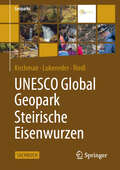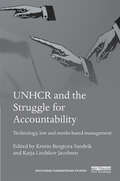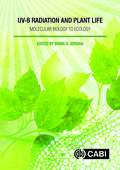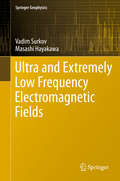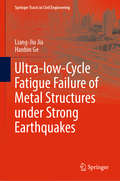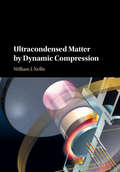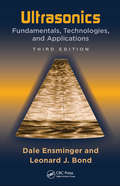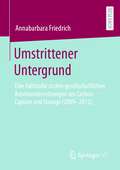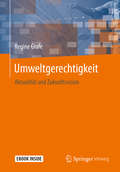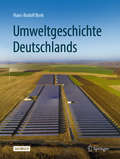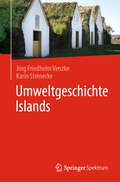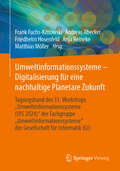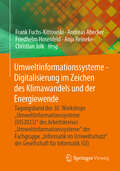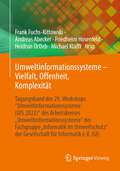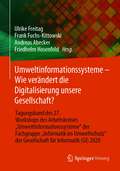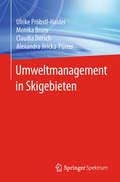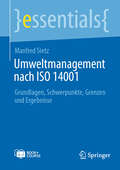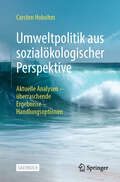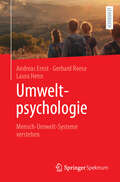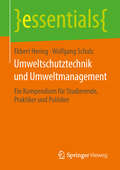- Table View
- List View
UNESCO Global Geopark Steirische Eisenwurzen (Geoparks)
by Gabriel Kirchmair Alexander Lukeneder Wolfgang Christoph RiedlWo sich Kultur und Natur im Einklang befinden Das Buch zeigt das wunderbare Erdmittelalter in den einstigen Meeresbecken des Natur- und Geoparks Steirische Eisenwurzen. Es führt durch gigantische Klimakatastrophen der Erdgeschichte und präsentiert diesen einzigartigen Park als Wunderkammer der Natur. Die Landschaft birgt Naturwunder wie Schneckenfriedhöfe, Massen an Ammoniten, imposante Bechermuschelriffe, Seelilienwälder und Gesteinsformationen mit Kuhtrittmuscheln. Highlights sind das Rätsel um ein verschwundenes Saurierskelett und die gewaltige Katastrophe an der KT-Grenze vor 66 Millionen Jahren. Der UNESCO Global Geopark Steirische Eisenwurzen liegt in den Nördlichen Kalkalpen, in der Mitte Österreichs. Die geologischen Besonderheiten und Landschaftsformen sind einzigartig in Österreich. Die Region besticht durch ihre Kulturgeschichte, Geodiversität und Biodiversität. Landschaften, über Jahrmillionen geprägt, bilden das Fundament für Abenteuer und Geschichten in der heutigen Zeit. Dieses Buch richtet sich an jeden, der geowissenschaftlich interessiert ist und plant, die einzigartige Geologie der Nördlichen Kalkalpen zu erleben und nimmt Sie mit auf eine erdgeschichtliche Entdeckungsreise im ältesten Geopark Österreichs.
UNHCR and the Struggle for Accountability: Technology, law and results-based management (Routledge Humanitarian Studies)
by Kristin Bergtora Sandvik Katja Lindskov JacobsenDespite the key importance of accountability for the legitimacy of humanitarian action, inadequate academic attention has been given to how the concept of accountability is evolving within the specific branches of the humanitarian enterprise. Up to now, there exists no comprehensive account of what we label the 'technologies of accountability', the effects of their interaction, or the question of how the current turn to decision-making software and biometrics as both the means and ends of accountability may contribute to reshaping humanitarian governance. UNHCR and the Struggle for Accountability explores the UNHCR's quest for accountability by viewing the UNHCR's accountability obligations through the web of institutional relationships within which the agency is placed (beneficiaries, host governments, implementing partners, donors, the Executive Committee and UNGA). The book takes a multidisciplinary approach in order to illuminate the various layers and relationships that constitute accountability and also to reflect on what constitutes good enough accountability. This book contributes to the discussion regarding how we construct knowledge about concepts in humanitarian studies and is a valuable resource for academics, researchers and professionals in the areas of anthropology, history, international relations, international law, science, technology studies and socio-legal studies.
UV-B Radiation and Plant Life: Molecular Biology to Ecology
by Marcel Jansen Pedro J. Aphalo Amy T. Austin Carlos L. Ballaré Paul W. Barnes Susanne Baldermann Melanie Binkert Janet F. Bornman Isabelle N. Bottger Stephan D. Flint Franziska S. Hanschen Éva Hideg Gareth I. Jenkins Karel Klem Susanne Neugart Monika Schreiner Åke Strid Mark A. Tobler Roman Ulm Otmar Urban Jason Wargent Melanie WiesnerUltraviolet-B radiation (UV-B) has profound effects on plant growth and development, and exposure varies with ozone depletion and across geographic regions, with ecosystem and agricultural consequences. This book deals with large-scale impacts but also how UV-B affects plants at the molecular level is also fascinating, and the UV-B photoreceptor has only recently been characterised. While UV-B radiation can be damaging, it also has a more positive role in plant photomorphogenesis. Consequently UV-B treatments are being developed as innovative approaches to improve horticulture. This book is a timely synthesis of what we know and need to know about UV-B radiation and plants.
Ubiquitous Mapping: Perspectives from Japan (Advances in Geographical and Environmental Sciences)
by Takashi Morita Yoshiki WakabayashiSince the last decades of the twentieth century, the circumstances surrounding map use and map making have drastically changed owing to advances in information and communication technologies (ICTs). In particular, the spread of web maps and mobile devices have altered the way people interact with maps. This book features the latest works on theoretical and practical issues of these changes by terming them “ubiquitous mapping”. In particular, the book pays attention to not only the technological basis but also multidisciplinary human–social aspects. The book covers the topics of the evaluation of ICT-based technologies for context-aware mapping, the theory and application of crowd-sourced geospatial information and collaborative mapping, and both the positive and negative effects of ubiquitous mapping on human society.
Ultra and Extremely Low Frequency Electromagnetic Fields
by Masashi Hayakawa Vadim SurkovThe major emphasis of this book is on physical mechanisms and sources of the ULF/ELF natural electromagnetic fields noises. In the course of this text, some of these mechanisms of magnetospheric origin will be treated in detail and others in a more sketchy fashion, while the global electromagnetic resonances excited by lightning activity and other sources are the priority. The interested reader is referred to the books cited in the text for details about the ULF/ELF fields of magnetospheric origin. Much emphasis is put on studies of electromagnetic phenomena caused by rock deformation/fracture including the ULF/ELF effects possibly associated with tectonic activity, earthquakes and other natural disasters. One of the challenges of this research is to fully understand electromagnetic effects and physical processes in the rocks deep in the Earth's crust.
Ultra-low-Cycle Fatigue Failure of Metal Structures under Strong Earthquakes (Springer Tracts in Civil Engineering)
by Liang-Jiu Jia Hanbin GeThis book presents experimental results and theoretical advances in the field of ultra-low-cycle fatigue failure of metal structures under strong earthquakes, where the dominant failure mechanism is ductile fracture. Studies on ultra-low-cycle fatigue failure of metal materials and structures have caught the interest of engineers and researchers from various disciplines, such as material, civil and mechanical engineering. Pursuing a holistic approach, the book establishes a fundamental framework for this topic, while also highlighting the importance of theoretical analysis and experimental results in the fracture evaluation of metal structures under seismic loading. Accordingly, it offers a valuable resource for undergraduate and graduate students interested in ultra-low-cycle fatigue, researchers investigating steel and aluminum structures, and structural engineers working on applications related to cyclic large plastic loading conditions.
Ultracondensed Matter by Dynamic Compression
by William J. NellisDynamic compression is an experimental technique with interdisciplinary uses, ranging from enabling the creation of ultracondensed matter under previously impossible conditions to understanding the likely cause of unusual planetary magnetic fields. Readers can now gain an intuitive understanding ofdynamic compression; clear and authoritative chapters examine its history and experimental method, as well as key topics including dynamic compression of liquid hydrogen, rare gas fluids and shock-induced opacity. Through an up-to-date history of dynamic compression research, Nellis also clearly shows how dynamic compression addresses and will continue to address major unanswered questions across the scientific disciplines. The past and future role of dynamic compression in studying and making materials at extreme conditions of pressure, density and temperature is made clear, and the means of doing so are explained in practical language perfectly suited for researchers and graduate students alike.
Ultrasonics: Fundamentals, Technologies, and Applications, Third Edition
by Dale Ensminger Leonard J. BondThe book provides a unique and comprehensive treatment of the science, technology, and applications for industrial and medical ultrasonics, including low- and high-power implementations. The discussion of applications is combined with the fundamental physics, the reporting of the sensors/transducers, and systems for the full spectrum of industrial, nondestructive testing, and medical/bio-medical uses. It includes citations of numerous references and covers both mainstream and the more unusual and obscure applications of ultrasound.
Ultrathin Carbon-Based Overcoats for Extremely High Density Magnetic Recording
by Reuben Jueyuan YeoThis book presents the latest research in ultrathin carbon-based protective overcoats for high areal density magnetic data storage systems, with a particular focus on hard disk drives (HDDs) and tape drives. These findings shed new light on how the microstructure and interfacial chemistry of these sub-20 nm overcoats can be engineered at the nanoscale regime to obtain enhanced properties for wear, thermal and corrosion protection – which are critical for such applications. Readers will also be provided with fresh experimental insights into the suitability of graphene as an atomically-thin overcoat for HDD media. The easy readability of this book will appeal to a wide audience, ranging from non-specialists with a general interest in the field to scientists and industry professionals directly involved in thin film and coatings research.
Umstrittener Untergrund: Eine Fallstudie zu den gesellschaftlichen Auseinandersetzungen um Carbon Capture and Storage (2009-2012)
by Annabarbara FriedrichDie Autorin analysiert die gesellschaftlichen Auseinandersetzungen um den frühen Implementierungsversuch einer Carbon Dioxide Removal Technologie. Diese Maßnahmen sind vom Weltklimarat als ein Baustein zur Eindämmung des Klimawandels anerkannt. Die EU setzte eine solche Technologie, Carbon Capture and Storage (CCS), bereits im Jahr 2009 auf die politische Agenda der Mitgliedstaaten. Die Arbeit untersucht die restriktive Regulierung der Kohlendioxidabscheidung und –speicherung in Deutschland, die im journalistisch-öffentlichen Diskurs auch als gescheitert dargestellt wird. Statt die (fehlende) öffentliche Akzeptanz von CCS zu erklären, untersucht die Arbeit die gesellschaftliche Politisierung des Technologie-Sets. Auf der Grundlage von Theorieansätzen der Science and Technology Studies werden die Deutungsrahmen von Interessengruppen auf Bundesebene analysiert. Die Inhaltsanalyse, der öffentlichen Dokumente von Gesellschaftsakteuren im Kontext des Gesetzgebungsverfahrens (2009-2012), zeigt die Verknüpfung von Carbon Capture and Storage und bestehenden soziotechnischen Systemen sowie deren gesellschaftspolitische Kontexte. Die qualitative Analyse behandelt ein vergangenes Beispiel einer umstrittenen technologischen Intervention. Dies ist zugleich zukunftsweisend, da nachträgliche Methoden der CO2-Entnahme aktuell im Zusammenhang von sog. unvermeidbaren Restemissionen erneut diskutiert werden.
Umweltgeologie: Eine Einführung in Grundlagen und Praxis
by Sylke HilbergDie Umweltgeologie befasst sich mit den Auswirkungen von menschlichen Aktivitäten auf die geologische Umwelt. Im Kontext von Klimawandel und Biodiversitätskrise scheint die Geologie auf den ersten Blick nur eine Nebenrolle zu spielen, ist sie doch die Wissenschaft, die sich mit der Erdkruste und allem, was darunterliegt, befasst. Dieses Lehrbuch bietet einen ausführlichen Überblick, welchen Beitrag die Umweltgeologie dazu leisten kann, negative Auswirkungen der aktuellen Veränderungen unserer Umwelt einzudämmen, bereits entstandene Umweltschäden zu sanieren und zukünftige zu verhindern.Dazu betrachtet der Grundlagenteil das geschlossene System Erde und die verschiedenen Teilbereiche Atmosphäre, Hydrosphäre, Pedosphäre und Lithosphäre. Die wichtigsten Stoffgruppen werden vorgestellt und geogene, aber auch anthropogen induzierte Stoffflüsse über die Grenzen der Lithosphäre hinweg diskutiert. Der Praxisteil stellt die wichtigsten Methoden der Umweltgeologie vor und unterzieht verschiedene Bereiche der angewandten Geologie einer Emissionsbetrachtung. Der Fokus liegt dabei auf Altlasten, Rohstoffen, Wasser und Energiebedarf. Die Vermittlung von Faktenwissen wird durch Fallbeispiele aus der Praxis der Autorin unterstützt. Die vorliegende zweite Auflage greift neue Erkenntnisse im Fachgebiet auf und ist ergänzt durch neue, wertvolle Erfahrungen der Autorin seit dem Erscheinen der ersten Auflage. Diese Einführung bietet Studierenden der Geowissenschaften und Biologie einen gut verständlichen Einstieg in die Umweltgeologie. Sie erklärt etablierte Lösungsansätze, zeigt aber auch bisher ungelöste Probleme im Wechselspiel von Mensch und Geologie auf. Dazu gehören zum Beispiel Fragen rund um „grüne Technologien“ der Energiewende oder auch Gewinnung und Einsatz von „Hightech-Rohstoffen“ und die damit verbundenen Umweltauswirkungen. Das Buch bietet damit eine Orientierung bei der kritischen Auseinandersetzung mit einigen der brennenden Fragen unserer Zeit.
Umweltgerechtigkeit: Aktualität und Zukunftsvision (Essentials Ser.)
by Regine GrafeEs wird die Komplexität von Umweltverschmutzung und Gesundheitsbeeinträchtigung im Kontext von sozialer Indikation dargestellt. Mit Hilfe von Sozialindikatoren wird aufgezeigt, wie Umweltverschmutzung, Gesundheitszustand, Bildungsteilhabe und Arbeitswelt auf die Menschen, insbesondere in Ballungsgebieten und in ausgewählten Innenstadtbereichen sowie in Satelitenstädten unmittelbar zusammenhängen. Die Bewertungsgrößen Predicted Mean Vote (PMV) und Physiological Equivalent Temperature (PET) werden im Kontext der Humanbiometereologie (HBM) ausführlich diskutiert Stadtklimatologie und Geometrie der Stadtarchitektur werden in Hinblick auf die urbane Gesundheit und die soziale Beeinflussungen der Bewohner dargestellt.
Umweltgeschichte Deutschlands
by Hans-Rudolf BorkDieses Buch gibt einen Einblick in die aufregenden, ungeheuer vielfältigen und häufig tragischen Beziehungen zwischen den Menschen in Deutschland und der sie umgebenden Natur. In chronologischer Abfolge – von der Römerzeit bis zur Gegenwart – erfahren Sie, auf welche unterschiedlichen Arten sich Mensch und Natur im Laufe der Geschichte prägen. Die 260 Etappen markieren wichtige oder bemerkenswerte Ereignisse der bewegten Umweltgeschichte Deutschlands: von den Auswirkungen der Viehhaltung, Bevölkerungswachstum und der Gewinnung von Ackerland auf Kosten artenreicher Ökosysteme über die zahlreichen Umweltbelastungen von Industrialisierung, Kohlebergbau und industrieller Landwirtschaft bis hin zur explosionsartigen Ausweitung von Konsum und Rohstoffverbrauch seit Mitte des 20. Jahrhunderts. Mit diesem Einblick in die Mensch-Umwelt-Beziehungen der Vergangenheit weist das Buch Wege in eine nachhaltig lebenswerte Zukunft, mit gesunden Menschen und einer intakten Umwelt.
Umweltgeschichte Islands
by Jörg Friedhelm Venzke Karin SteineckeIsland, dicht südlich des Polarkreises und fernab von Europa und Nordamerika im subarktischen Milieu des Nordatlantiks gelegen, fasziniert seit jeher Forscher und Reisende mit seiner einzigartigen Natur und Naturgeschichte. Doch nicht Vulkane und Gletscher stehen im Fokus dieses Buches, sondern die über tausendjährige, historisch recht junge Auseinandersetzung des Menschen mit den physischen Herausforderungen der Insel. Aus einst ursprünglichen und unberührten Landschaften wurden teils übernutzte, devastierte Gebiete. Gleichzeitig ermöglichen nahezu unbegrenzte Ressourcen aus Wasserkraft und Geothermie eine weitgehend CO₂-freie Zukunft – doch wo liegen hier die Grenzen des Wachstums? Die Entwicklung Islands wird aus geo- und umweltwissenschaftlicher sowie historischer Perspektive beleuchtet: von der mittelalterlichen Besiedlung über die Zeit der Abhängigkeit als dänische Kolonie und die Entwicklung in der Selbstständigkeit nach dem Zweiten Weltkrieg bis hin zur modernen Gesellschaft. Wissenschaftliche Analysen, statistische Daten und journalistische Quellen bieten ein vielschichtiges Bild der Umweltgeschichte der Insel. Das Buch richtet sich an Studierende, Lehrende der Geo- und Umweltwissenschaften und Interessierte, die fundierte Einblicke in die Mensch-Umwelt-Beziehungen Islands gewinnen möchten. Es ist hervorragend zur Vor- und Nachbereitung von Island-Exkursionen geeignet.
Umweltinformationssysteme - Digitalisierung für eine nachhaltige Planetare Zukunft: Tagungsband des 31. Workshops “Umweltinformationssysteme (UIS 2024)" der Fachgruppe „Umweltinformationssysteme" der Gesellschaft für Informatik (GI)
by Frank Fuchs-Kittowski Andreas Abecker Friedhelm Hosenfeld Matthias Möller Anja ReinekeDas Ziel der Workshop-Reihe „Umweltinformationssysteme (UIS)“ ist es, den neuesten Stand von Forschung und Entwicklung auf dem Gebiet der Umweltinformatik (UI) und in umweltbezogenen IT-Anwendungsbereichen vorzustellen und zu diskutieren. Dies umfasst sowohl Konzepte und Anwendungen von UIS als auch Technologien, die moderne UIS unterstützen. Das Buch adressiert alle für UIS-Theorie und -Praxis relevanten Themen wie: Datenerzeugung, Datenbereitstellung, Datenanalyse und Künstliche Intelligenz (KI/AI), Datennutzung und -visualisierung, Vernetzung von Anwendungen, Software Engineering für UIS, Klimawandel und Resilienz.
Umweltinformationssysteme - Digitalisierung im Zeichen des Klimawandels und der Energiewende: Tagungsband des 30. Workshops “Umweltinformationssysteme (UIS2023)“ des Arbeitskreises „Umweltinformationssysteme“ der Fachgruppe „Informatik im Umweltschutz‘‘ der Gesellschaft für Informatik (GI)
by Frank Fuchs-Kittowski Andreas Abecker Friedhelm Hosenfeld Anja Reineke Christian JolkDer neueste Stand der Forschung und Entwicklung auf dem Gebiet der Umweltinformatik (UI) und umweltbezogener IT-Anwendungsbereiche wird in diesem Tagungsband präsentiert und kritisch diskutiert. Dies umfasst sowohl Konzepte und Anwendungen von Umweltinformationssystemen als auch Technologien, die moderne Umweltinformationssysteme unterstützen und ermöglichen.
Umweltinformationssysteme - Wie trägt die Digitalisierung zur Nachhaltigkeit bei?: Tagungsband des 28. Workshops “Umweltinformationssysteme (UIS 2021)“ des Arbeitskreises „Umweltinformationssysteme“ der Fachgruppe „Informatik im Umweltschutz‘‘ der Gesellschaft für Informatik (GI)
by Frank Fuchs-Kittowski Andreas Abecker Friedhelm HosenfeldDer neueste Stand der Forschung und Entwicklung auf dem Gebiet der Umweltinformatik (UI) und umweltbezogener IT-Anwendungsbereiche wird in diesem Tagungsband präsentiert und kritisch diskutiert. Dies umfasst sowohl Konzepte und Anwendungen von Umweltinformationssystemen als auch Technologien, die moderne Umweltinformationssysteme unterstützen und ermöglichen.
Umweltinformationssysteme – Vielfalt, Offenheit, Komplexität: Tagungsband des 29. Workshops “Umweltinformationssysteme (UIS 2022)“ des Arbeitskreises „Umweltinformationssysteme“ der Fachgruppe „Informatik im Umweltschutz‘‘ der Gesellschaft für Informatik e.V. (GI)
by Frank Fuchs-Kittowski Andreas Abecker Friedhelm Hosenfeld Heidrun Ortleb Michael KlafftDer neueste Stand der Forschung und Entwicklung auf dem Gebiet der Umweltinformatik (UI) und umweltbezogener IT-Anwendungsbereiche wird in diesem Tagungsband präsentiert und kritisch diskutiert. Dies umfasst sowohl Konzepte und Anwendungen von Umweltinformationssystemen als auch Technologien, die moderne Umweltinformationssysteme unterstützen und ermöglichen.
Umweltinformationssysteme – Wie verändert die Digitalisierung unsere Gesellschaft?: Tagungsband des 27. Workshops des Arbeitskreises „Umweltinformationssysteme“ der Fachgruppe „Informatik im Umweltschutz‘‘ der Gesellschaft für Informatik (GI) 2020
by Frank Fuchs-Kittowski Ulrike Freitag Andreas Abecker Friedhelm HosenfeldDurch welche Methoden und Techniken der (Umwelt-)Informatik sind Fachverfahren in einzelnen Informationssystemen adäquat zu unterstützen? Wie ist das Zusammenspiel mehrerer Umweltinformationssysteme zur Beantwortung weitergehender Fragestellungen zu organisieren? Aktuelle Forschungsergebnisse, Anwendungen und Lösungen, aber auch Forschungsideen und neue Ansätze werden in diesem Tagungsband präsentiert und kritisch diskutiert.
Umweltmanagement in Skigebieten
by Ulrike Pröbstl-Haider Monika Brom Claudia Dorsch Alexandra Jiricka-PürrerDas vorliegende Buch zeigt, welche ökonomischen, ökologischen und rechtlichen Vorteile für Unternehmen entstehen, wenn sie die sensible Bergwelt so schonend wie möglich nutzen. Einsparpotenziale werden ebenso thematisiert wie ökologische Verbesserungen durch Pistenpflege oder Maßnahmen zum Vogelschutz. Ausführlich kommen auch die innerbetrieblichen Effekte zur Sprache, wie ein erhöhtes Engagement der Mitarbeiter durch die Beteiligung am Umweltmanagementsystem.Dieses Buch soll dazu beitragen, die Anzahl zertifizierter Skigebiete zu erhöhen sowie eine generelle Sensibilität für umwelt- und ressourcenschonendes Management in Wintersportgebieten zu erzeugen. Skigebietsbetreiber, Kommunen und beteiligte Planungs- und Beratungsbüros finden hier wertvolle Hinweise und Checklisten, die den Weg zu einem naturverträglichen Skigebietsmanagement erleichtern. Die Ausführungen werden durch Praxisbeispiele aus diversen Skigebieten anschaulich illustriert.
Umweltmanagement nach ISO 14001: Grundlagen, Schwerpunkte, Grenzen und Ergebnisse (essentials)
by Manfred SietzUmweltmanagement eines Unternehmens bedeutet, die Umweltauswirkungen minimierend zu managen, um die Qualität unserer Umwelt zu erhalten oder zu verbessern. Managen bedeutet in der Originalübersetzung etwas zu verwalten. Also eine Aufgabe mit Verantwortung, Zielen und Aktivitäten. Alle diese Managementtools werden zuzusammengefasst in der weltweit gültigen und zertifizierbaren Norm ISO 14001.
Umweltpolitik aus sozialökologischer Perspektive: Aktuelle Analysen - überraschende Ergebnisse - Handlungsoptionen
by Carsten HobohmAngesichts einer zunehmend bedrohlichen Kulisse stellt sich die Frage, wie der Klimawandel, die Intensivierung der Nutzung von Ökosystemen und die Bedrohung der Artenvielfalt das soziale und kulturelle Leben beeinflussen. In den Medien haben Katastrophenmeldungen zweifellos zugenommen. Doch in welcher Weise das gesellschaftliche Leben oder die Menschheit insgesamt durch Umweltkatastrophen konkret bedroht ist, wird bislang nur selten in ausreichender Detailschärfe dargestellt. Mit dieser Analyse wird versucht, den Knoten der gelegentlich einseitigen Betrachtung zu lösen und den Blickwinkel um einige Möglichkeiten der Ausgestaltung von Zukunft zu erweitern. Eine ganze Palette von Möglichkeiten zielt darauf ab, den Fokus der global dunklen, gleichzeitig unscharfen oder sogar verschwommenen Perspektiven um positive Ansätze in der lokalen und regionalen Dimension zu erweitern. Möglichkeiten sind reichlich vorhanden, aber sie sind nicht zum Nulltarif zu realisieren.
Umweltpsychologie: Mensch-Umwelt-Systeme verstehen
by Gerhard Reese Andreas Ernst Laura HennKlimakatastrophe, Umweltkrisen, Ressourcenknappheit – und das alles mit uns Menschen mittendrin, als zentrale Ursache, aber auch als Betroffene. Wie konnte es dazu kommen und wie kommen wir da wieder heraus? Um Mensch-Umwelt-Systeme zu verstehen, bietet die Umweltpsychologie wertvolle Ansätze. Was können wir als Einzelne, was können wir gemeinsam tun, um diese Herausforderungen zu bewältigen? Warum geht es (scheinbar) nicht weiter in Richtung Nachhaltigkeit? Wie sieht ein nachhaltiges Leben denn aus und was erwartet uns in der Zukunft möglicherweise? Ist eine Entwicklung in Richtung Nachhaltigkeit überhaupt zu schaffen und wenn ja, wie? Dieses umfassende Lehrbuch zeigt, wie menschliches Handeln mit gesellschaftlichen Dynamiken und der Umwelt verknüpft ist und wie sich diese gegenseitig beeinflussen. Anhand von Alltagssituationen und aktuellen Themen veranschaulicht es umweltpsychologische Erkenntnisse und liefert gleichzeitig die natur- und umweltwissenschaftlichen Grundlagen, die für ein fundiertes Verständnis von Umweltverhalten unerlässlich sind. Zudem stellt es dar, unter welchen individuellen, sozialen und systemischen Bedingungen eine gesellschaftliche Transformation gelingen kann, die Wohlstand und Wohlbefinden im Einklang mit den planetaren Grenzen ermöglicht. Das Buch bietet auch für Interessierte aus anderen Disziplinen und aus der Praxis eine verständliche Darstellung der wissenschaftlichen Grundlagen der Umweltpsychologie.
Umweltschutztechnik und Umweltmanagement: Ein Kompendium für Studierende, Praktiker und Politiker (essentials)
by Ekbert Hering Wolfgang SchulzDie Autoren beschreiben Gefährdungspotenziale für Luft, Wasser und Boden und den globalen Klimawandel sowie Maßnahmen zur Gegensteuerung. Sie stellen Konzepte zur Abfallwirtschaft vor und verweisen auf die Verankerung des Umweltschutzes in Unternehmen durch ein effizientes Umweltmanagement und einer Ökobilanz. So können Leser die globale Aufgabe, die Umwelt zu schützen, mit nationalen und internationalen politischen Rahmenbedingungen und vor allem dem Wissen im Bereich der Naturwissenschaften einschätzen und Umweltschäden vermeiden oder ihre Auswirkungen verringern. Die Politik schafft dazu auf nationaler, europäischer und internationaler Ebene mit Gesetzen, Regelungen und Normen die Voraussetzungen.Die AutorenDr. rer. nat. Dr. rer. pol. Dr. h.c. Ekbert Hering lehrt und forscht an der Hochschule Aalen. Er ist Verfasser erfolgreicher Fachbücher in renommierten Verlagen. Dr. rer. nat. Wolfgang Schulz ist Leiter der Forschung und Entwicklung Sonderanalytik beim Zweckverband Landeswasserversorgung und Lehrbeauftragter an der Hochschule Aalen.
Un Remedio Teológico para la Crisis Ambiental
by Joseph HabamahirweLas conferencias internacionales sobre el medio ambiente, como la de Río en 1992, han hecho buenas políticas ambientales. Desafortunadamente, tales políticas no se han implementado lo suficiente. Esta situación refleja la falta de interés por parte de los países desarrollados, así como la falta de tenacidad por parte de los países en desarrollo. Por lo tanto, dicha tenacidad es necesaria para resolver el problema aparentemente insoluble de la contaminación ambiental. Las Naciones Unidas han establecido un Programa Ambiental (PNUMA) para abordar los problemas ambientales a nivel mundial. Aún así, hay mucho por hacer. Este libro presenta el estado de la actual crisis ambiental global, sus causas y efectos, tanto para los seres humanos como para la naturaleza misma. Hace un llamado a activistas ambientales, científicos, estudiantes, conferenciantes, líderes eclesiásticos y líderes políticos para detener esta crisis que podría persistir durante muchos años y empeorar progresivamente si el mundo no llega a una solución pronto.
